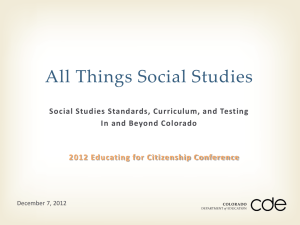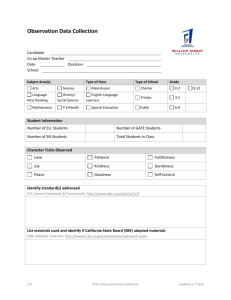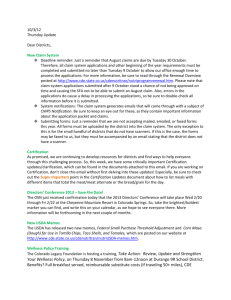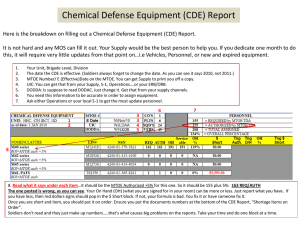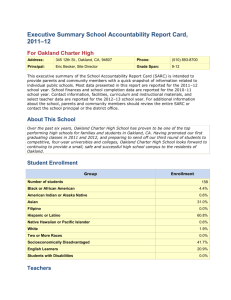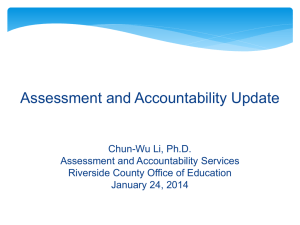to view the 2009-2010 SARC for Coryell Autism Center
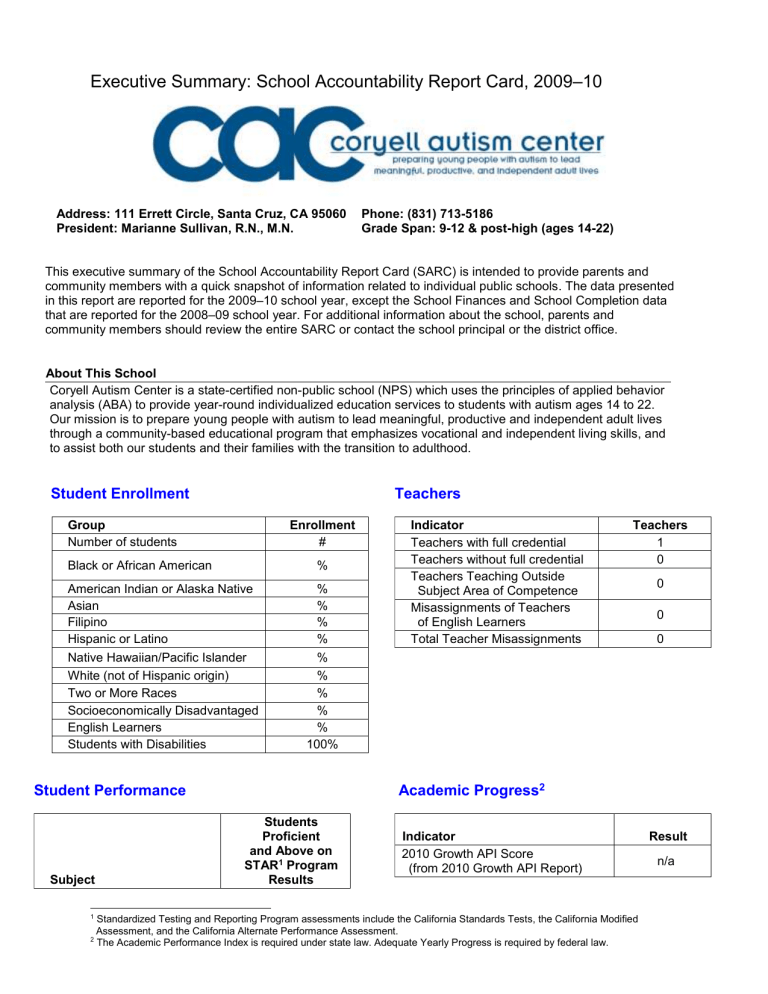
Executive Summary: School Accountability Report Card, 2009 –10
Address: 111 Errett Circle, Santa Cruz, CA 95060 Phone: (831) 713-5186
President: Marianne Sullivan, R.N., M.N.
Grade Span: 9-12 & post-high (ages 14-22)
This executive summary of the School Accountability Report Card (SARC) is intended to provide parents and community members with a quick snapshot of information related to individual public schools. The data presented in this report are reported for the 2009 –10 school year, except the School Finances and School Completion data that are reported for the 2008 –09 school year. For additional information about the school, parents and community members should review the entire SARC or contact the school principal or the district office.
A About This School
Coryell Autism Center is a state-certified non-public school (NPS) which uses the principles of applied behavior analysis (ABA) to provide year-round individualized education services to students with autism ages 14 to 22.
Our mission is to prepare young people with autism to lead meaningful, productive and independent adult lives through a community-based educational program that emphasizes vocational and independent living skills, and to assist both our students and their families with the transition to adulthood.
Student Enrollment
Group Enrollment
Teachers
Indicator Teachers
Number of students # Teachers with full credential
Teachers without full credential
Black or African American %
1
0
American Indian or Alaska Native
Asian
Filipino
Hispanic or Latino
%
%
%
%
Teachers Teaching Outside
Subject Area of Competence
Misassignments of Teachers
of English Learners
Total Teacher Misassignments
0
0
0
Native Hawaiian/Pacific Islander
White (not of Hispanic origin)
%
%
Two or More Races %
Socioeconomically Disadvantaged
English Learners
Students with Disabilities
Student Performance
Subject
%
%
100%
Students
Proficient and Above on
STAR 1 Program
Results
Academic Progress 2
Indicator
2010 Growth API Score
(from 2010 Growth API Report)
Result n/a
1 Standardized Testing and Reporting Program assessments include the California Standards Tests, the California Modified
Assessment, and the California Alternate Performance Assessment.
2
The Academic Performance Index is required under state law. Adequate Yearly Progress is required by federal law.
English-Language Arts
Mathematics
Science
History-Social Science n/a n/a n/a n/a
School Facilities
Summary of Most Recent Site Inspection n/a
Repairs Needed n/a
Corrective Actions Taken or Planned n/a
Curriculum and Instructional Materials
Core Curriculum Area
Pupils Who Lack
Textbooks and
Instructional
Materials
Reading/Language Arts
Mathematics
Science
History-Social Science
Foreign Language
Health
Visual and Performing Arts
Science Laboratory Equipment
(grades 9-12)
School Completion
Indicator
Graduation Rate (if applicable) n/a n/a n/a n/a n/a n/a n/a n/a
Result n/a
Statewide Rank
(from 2009 Base API Report)
Met All 2010 AYP Requirements
Number of AYP Criteria Met Out of the Total Number of Criteria Possible
2010 –11 Program Improvement
Status (PI Year)
School Finances
Level
School Site
District
State
Postsecondary Preparation
Measure
Pupils Who Completed a Career
Technical Education Program and
Earned a High School Diploma
Graduates Who Completed All
Courses Required for University of
California or California State
University Admission n/a n/a n/a n/a
Expenditures
Per Pupil
(Unrestricted
Sources Only) n/a n/a n/a
Percent n/a n/a
School Accountability Report Card
Reported Using Data from 2009 –10 School Year
Published During 2010 –11
The School Accountability Report Card (SARC), which is required by law to be published by February 1 of each year, contains information about the condition and performance of each California public school.
More information about SARC requirements is available on the California Department of Education (CDE)
SARC Web page at http://www.cde.ca.gov/ta/ac/sa/ . For additional information about the school, parents and community members should contact the school principal or the district office.
I. Data and Access
DataQuest
DataQuest is an online data tool located on the CDE DataQuest Web page at http://dq.cde.ca.gov/dataquest/ that contains additional information about this school and comparisons of the school to the district, the county, and the state. Specifically, DataQuest is a dynamic system that provides reports for accountability (e.g., state Academic Performance Index [API], federal Adequate
Yearly Progress [AYP]), test data, enrollment, high school graduates, dropouts, course enrollments, staffing, and data regarding English learners.
Internet Access
Internet access is available at public libraries and other locations that are publicly accessible (e.g., the
California State Library). Access to the Internet at libraries and public locations is generally provided on a first-come, first-served basis. Other use restrictions may include the hours of operation, the length of time that a workstation may be used (depending on availability), the types of software programs available on a workstation, and the ability to print documents.
II. About This School
Contact Information (School Year 2010
–11)
This section provides the school’s contact information.
School District
School
Name
Street
City, State,
Zip
Coryell Autism Center
111 Errett Circle
Santa Cruz, CA 95060
District Name* Santa Cruz City Schools
Phone Number (831) 429-3410
Web Site http://www.sccs.santacruz.k12.ca.us/
Phone
Number
(831) 713-5186
President Marianne Sullivan, R.N., M.N.
Superintendent Gary Bloom
E-mail Address gsbloom@sccs.santacruz.k12.ca.us/
Address info@coryellautismcenter.org CDS Code N/A
*Coryell Autism Center Is located within the Santa Cruz City Schools geographical area, but operates under the authority of the Santa Cruz County Office of Education and via contracts arranged with the home districts of individual students.
School Description and Mission Statement (School Year 2009
–10)
This section provides information about the school, its programs, and its goals.
Coryell Autism Center (CAC) is a state-certified non-public school (NPS) established in 2007. CAC provides year-round individualized education services to students with autism ages 14 to 22. Our mission is to prepare young people with autism to lead meaningful, productive and independent adult lives through a community-based educational program that emphasizes vocational and independent living skills, and to assist both our students and their families with the transition to adulthood.
CAC’s education and treatment approach is based on the principles of applied behavior analysis (ABA), which refers to carefully-designed intervention programs that use scientifically-validated principles of behavior and are monitored by objective data measures to assess both teaching procedures and desired outcomes. Skills are systematically taught through highly-structured individualized and small-group teaching sessions across five major skill areas: community, domestic, functional academics, recreation & leisure, and vocational.
Each student at CAC is taught according to his or her annual individualized education program (IEP), as well as his or her individualized transition plan (ITP) for any student age 16 to 22. In addition, a positive behavior support plan (PBSP), including the teaching of prosocial behaviors and effective self-advocacy, is developed for each student in order to promote access to the most effective and least restrictive environments both at CAC and beyond. All students begin an ongoing process of r ésumé-building upon enrollment at Coryell Autism Center; opportunities for supported employment in the community are provided to students beginning at age 16.
CAC staff participate in regularly-scheduled in-service and staff development activities, including participation in major regional and national conferences. The CAC library includes books, textbooks, manuals, curriculum and current peer-reviewed journal articles pertinent to the education and treatment of individuals with autism, particularly teenagers and young adults. CAC library resources are available both onsite and on loan to all staff, as well as to both students and their families.
Coryell Autism Center conducts yearly comprehensive program evaluations consisting of internal and external evaluations of student and employee performance.
Opportunities for Parental Involvement (School Year 2009
–10)
This section provides information about opportunities for parents to become involved with school activities, including contact information pertaining to organized opportunities for parental involvement. n/a
Student Enrollment by Grade Level (School Year 2009
–10)
This table displays the number of students enrolled in each grade level at the school.
Grade Level Number of Students Grade Level Number of Students
Kindergarten
Grade 1
Grade 2
Grade 3
Grade 4
Grade 5
Grade 6
Grade 7 n/a n/a n/a n/a n/a n/a n/a n/a
Grade 8
Ungraded Elementary
Grade 9
Grade 10
Grade 11
Grade 12
Ungraded Secondary
Total Enrollment n/a n/a n/a n/a n/a n/a n/a n/a
Student Enrollment by Group (School Year 2009 –10)
This table displays the percent of students enrolled at the school who are identified as being in a particular group.
Group
Percent of
Total
Enrollment n/a
Group
White
Two or More Races
Percent of
Total
Enrollment n/a Black or African American
American Indian or Alaska
Native
Asian n/a n/a
Filipino
Hispanic or Latino
Native Hawaiian/Pacific
Islander n/a n/a n/a n/a
Socioeconomically
Disadvantaged
English Learners
Students with Disabilities n/a n/a n/a n/a
Average Class Size and Class Size Distribution (Elementary)
Not applicable to CAC.
Average Class Size and Class Size Distribution (Secondary)
Not applicable to CAC.
III. School Climate
School Safety Plan (School Year 2009 –10)
This section provides information about the school's comprehensive safety plan.
Coryell Autism Center provides a safe, healthy, and accessible environment for all students and employees, and follows standard protocols to ensure safety in case of an emergency. An Emergency
Response Guide is located in each classroom and contains safety procedures and reporting requirements.
Suspensions and Expulsions
This table displays the rate of suspensions and expulsions (the total number of incidents divided by the total enrollment) at the school and district levels for the most recent three-year period.
Rate
Suspensions
Expulsions
2007 –08 n/a n/a
School
2008 –09 n/a n/a
2009 –10 n/a n/a
2007 –08
District
2008 –09 2009 –10
IV. School Facilities
School Facility Conditions and Planned Improvements (School Year 2010 –11)
This section provides information about the condition of the school’s grounds, buildings, and restrooms based on the most recent data available, and a description of any planned or recently completed facility improvements. n/a
School Facility Good Repair Status (School Year 2010 –11)
This table displays the results of the most recently completed school site inspection to determine the school facility’s good repair status.
Repair Status
System Inspected
Exemplary Good Fair Poor
Repair Needed and
Action Taken or Planned
Systems: Gas Leaks,
Mechanical/HVAC,
Sewer
Interior: Interior
Surfaces
Cleanliness: Overall
Cleanliness, Pest/
Vermin Infestation
Electrical: Electrical
Restrooms/Fountains:
Restrooms, Sinks/
Fountains
Safety: Fire Safety,
Hazardous Materials
Structural: Structural
Damage, Roofs
External:
Playground/School
Grounds, Windows/
Doors/Gates/Fences
Overall Rating
V. Teachers
Teacher Credentials n/a n/a n/a n/a n/a n/a n/a n/a n/a n/a n/a n/a n/a n/a n/a n/a n/a n/a n/a n/a n/a n/a n/a n/a n/a n/a n/a n/a n/a n/a n/a n/a n/a n/a n/a n/a n/a n/a n/a n/a n/a n/a n/a n/a n/a
This table displays the number of teachers assigned to the school with a full credential, without a full credential, and those teaching outside of their subject area of competence. Detailed information about teacher qualifications can be found on the CDE DataQuest Web page at http://dq.cde.ca.gov/dataquest/ .
Teachers
2007 –08
School
2008 –09 2009 –10
District
2009 –10
With Full Credential n/a n/a 1 n/a n/a 0 Without Full Credential
Teaching Outside Subject Area of
Competence n/a n/a 0
Teacher Misassignments and Vacant Teacher Positions
This table displays the number of teacher misassignments (teachers assigned without proper legal authorization) and the number of vacant teacher positions (not filled by a single designated teacher assigned to teach the entire course at the beginning of the school year or semester). Note: Total Teacher
Misassignments includes the number of Misassignments of Teachers of English Learners .
Indicator 2008 –09 2009 –10 2010 –11
Misassignments of Teachers of English
Learners n/a 0 0
Total Teacher Misassignments n/a 0 0
Vacant Teacher Positions n/a 0 0
Core Academic Classes Taught by Highly Qualified Teachers (School Year 2009 –
10)
This table displays the percent of classes in core academic subjects taught by Highly Qualified Teachers as defined in the Elementary and Secondary Education Act (ESEA), in a school, in all schools in the
district, in high-poverty schools in the district, and in low-poverty schools in the district. High poverty schools are defined as those schools with student eligibility of approximately 40 percent or more in the free and reduced price meals program. Low poverty schools are those with student eligibility of approximately 25 percent or less in the free and reduced price meals program. More information on teacher qualifications required under the ESEA can be found on the CDE Improving Teacher and
Principal Quality Web page at http://www.cde.ca.gov/nclb/sr/tq/ .
Percent of Classes In Core Academic Subjects
Location of Classes
Taught by
Highly Qualified Teachers n/a
Not Taught by
Highly Qualified Teachers n/a This School
All Schools in District
High-Poverty Schools in
District
Low-Poverty Schools in District
VI. Support Staff
Academic Counselors and Other Support Staff (School Year 2009 –10)
This table displays, in units of full-time equivalents (FTE), the number of academic counselors and other support staff who are assigned to the school and the average number of students per academic counselor. One FTE equals one staff member working full time; one FTE could also represent two staff members who each work 50 percent of full time.
Title
Number of FTE
Assigned to School
Average Number of
Students per
Academic Counselor n/a n/a Academic Counselor
Counselor (Social/Behavioral or Career
Development) n/a n/a
Library Media Teacher (librarian)
Library Media Services Staff
(paraprofessional)
Psychologist
Social Worker
Nurse
Speech/Language/Hearing Specialist n/a n/a n/a n/a n/a n/a n/a n/a n/a n/a
Resource Specialist (non-teaching) n/a n/a n/a n/a
Other n/a n/a
VII. Curriculum and Instructional Materials
Quality, Currency, Availability of Textbooks and Instructional Materials (School
Year 2010 –11)
This table displays information about the quality, currency, and availability of the standards-aligned textbooks and other instructional materials used at the school; whether the textbooks and instructional materials are from the most recent adoption (yes/no); and information about the school’s use of any supplemental curriculum or non-adopted textbooks or instructional materials.
Core Curriculum Area
Quality, Currency, and Availability of
Textbooks and
Instructional
Percent of Pupils
Who Lack Their
Own
Assigned
Most Recent SBE or
Local Governing
Agency Approved
Textbooks and
Materials Textbooks and/or
Instructional
Materials
Instructional
Materials
Reading/Language Arts
Mathematics
Science
History-Social Science
Foreign Language
Health
Visual and Performing Arts
Science Laboratory Equipment
(grades 9-12) n/a n/a n/a n/a n/a n/a n/a n/a n/a n/a n/a n/a n/a n/a n/a n/a n/a n/a n/a n/a n/a n/a n/a n/a
VIII. School Finances
Expenditures Per Pupil and School Site Teacher Salaries (Fiscal Year 2008 –09)
This table displays a comparison of the school’s per pupil expenditures from unrestricted (basic) sources with other schools in the district and throughout the state, and a comparison of the average teacher salary at the school site with average teacher salaries at the district and state levels. Detailed information regarding school expenditures can be found on the CDE Current Expense of Education & Per-pupil
Spending Web page at http://www.cde.ca.gov/ds/fd/ec/ and teacher salaries can be found on the CDE
Certificated Salaries & Benefits Web page at http://www.cde.ca.gov/ds/fd/cs/ .
Level
Total
Expenditures
Per Pupil
Expenditures
Per Pupil
(Supplemental
/
Restricted)
Expenditures
Per Pupil
(Basic /
Unrestricted)
Average
Teacher
Salary n/a n/a n/a n/a n/a n/a
School Site
District
Percent Difference – School Site and
District n/a n/a n/a
State
Percent Difference – School Site and
State n/a n/a
Types of Services Funded (Fiscal Year 2009 –10) n/a n/a n/a n/a n/a n/a n/a n/a n/a
This section provides information about the programs and supplemental services (e.g., information about supplemental educational services related to the school’s federal Program Improvement status) that are provided at the school through either categorical funds or other sources. n/a
Teacher and Administrative Salaries (Fiscal Year 2008
–09)
This table displays district salaries for teachers, principals, and superintendents, and compares these figures to the state averages for districts of the same type and size. The table also displays teacher and administrative salaries as a percent of a district's budget, and compares these figures to the state averages for districts of the same type and size based on the salary schedule. Detailed information regarding salaries may be found on the CDE Certificated Salaries & Benefits Web page at http://www.cde.ca.gov/ds/fd/cs/ .
Category
District
Amount
State Average
For Districts
In Same Category
Beginning Teacher Salary
Mid-Range Teacher Salary
Highest Teacher Salary
Average Principal Salary (Elementary)
Average Principal Salary (Middle)
Average Principal Salary (High)
Superintendent Salary
Percent of Budget for Teacher Salaries
Percent of Budget for Administrative Salaries
IX. Student Performance
Standardized Testing and Reporting Program
The Standardized Testing and Reporting (STAR) Program consists of several key components, including the California Standards Tests (CSTs); the California Modified Assessment (CMA), and the California
Alternate Performance Assessment (CAPA). The assessments under the STAR program show how well students are doing in relation to the state content standards. The CSTs include English-language arts
(ELA) and mathematics in grades two through eleven; science in grades five, eight, and nine through eleven; and history-social science in grades eight, and nine through eleven. The CAPA includes ELA and mathematics in grades two through eleven, and science for grades five, eight, and ten. The CAPA is given to those students with significant cognitive disabilities whose disabilities prevent them from taking either the CSTs with accommodations or modifications or the CMA with accommodations. The CMA is an alternate assessment that is based on modified achievement standards in ELA for grades three through nine, mathematics for grades three through seven and Algebra I and science in grades five, eight, and ten. The CMA is designed to assess those students whose disabilities preclude them from achieving grade-level proficiency on an assessment of the California content standards with or without accommodations. On each of these assessments, student scores are reported as performance levels.
Detailed information regarding the STAR Program results for each grade and performance level, including the percent of students not tested, can be found on the CDE Standardized Testing and Reporting (STAR)
Results Web site at http://star.cde.ca.gov
. Program information regarding the STAR Program can be found in the Explaining 2009 STAR Program Summary Results to the Public guide at http://www.cde.ca.gov/ta/tg/sr/documents/pkt5intrpts09.pdf
.
Note: Scores are not shown when the number of students tested is ten or less, either because the number of students in this category is too small for statistical accuracy or to protect student privacy. In no case shall any group score be reported that would deliberately or inadvertently make public the score or performance of any individual student.
Standardized Testing and Reporting Results for All Students
– Three-Year
Comparison
This table displays the percent of students achieving at the Proficient or Advanced level (meeting or exceeding the state standards).
Subject
School District State
2007 –08 2008–09 2009–10 2007–08 2008–09 2009–10 2007–08 2008–09 2009–10
English-
Language
Arts n/a n/a n/a n/a n/a n/a Mathematics
Science
History-
Social
Science n/a n/a n/a n/a n/a n/a
Standardized Testing and Reporting Results by Student Group
– Most Recent
Year
This table displays the percent of students, by group, achieving at the Proficient or Advanced level
(meeting or exceeding the state standards) for the most recent testing period.
Percent of Students Scoring at Proficient or Advanced
Group English-
Language Arts
Mathematics Science
History-
Social Science
All Students in the LEA
All Students at the School
Male
Female
Black or African American
American Indian or Alaska
Native
Asian
Filipino n/a n/a n/a n/a
Hispanic or Latino
Native Hawaiian or Pacific
Islander
White
Two or More Races
Socioeconomically
Disadvantaged
English Learners
Students with Disabilities
Students Receiving Migrant
Education Services
California High School Exit Examination
The California High School Exit Examination (CAHSEE) is primarily used as a graduation requirement.
However, the grade ten results of this exam are also used to establish the percentages of students at three proficiency levels (not proficient, proficient, or advanced) in ELA and mathematics in order to compute AYP designations as required by the federal NCLB Act of 2001. Detailed information regarding
CAHSEE results can be found on the CDE California High School Exit Examination (CAHSEE) Web site at http://cahsee.cde.ca.gov/ . Note: Scores are not shown when the number of students tested is ten or less, either because the number of students in this category is too small for statistical accuracy, or to protect student privacy. In no case shall any group score be reported that would deliberately or inadvertently make public the score or performance of any individual student.
California High School Exit Examination Results for All Grade Ten Students –
Three-Year Comparison (if applicable)
Not applicable to CAC.
California High School Exit Examination Grade Ten Results by Student Group –
Most Recent Year (if applicable)
Not applicable to CAC.
California Physical Fitness Test Results (School Year 2009 –10)
The California Physical Fitness Test is administered to students in grades five, seven, and nine only. This table displays by grade level the percent of students meeting the fitness standards for the most recent testing period. Detailed information regarding this test, and comparisons of a school’s test results to the district and state levels, may be found on the CDE Physical Fitness Testing Web page at http://www.cde.ca.gov/ta/tg/pf/ . Note: Scores are not shown when the number of students tested is ten or
less, either because the number of students in this category is too small for statistical accuracy, or to protect student privacy. In no case shall any group score be reported that would deliberately or inadvertently make public the score or performance of any individual student.
Percent of Students Meeting Fitness Standards
Grade Level
Four of Six
Standards
Five of Six
Standards
Six of Six
Standards
5
7 n/a n/a n/a n/a n/a n/a
9 n/a n/a n/a
X. Accountability
Academic Performance Index
The Academic Performance Index (API) is an annual measure of state academic performance and progress of schools in California. API scores range from 200 to 1,000, with a statewide target of 800.
Detailed information about the API can be found on the CDE Academic Performance Index (API) Web page at http://www.cde.ca.gov/ta/ac/ap/ .
Academic Performance Index Ranks: Three-Year Comparison
This table displays the school’s statewide and similar schools’ API ranks. The statewide API rank ranges from 1 to 10. A statewide rank of 1 means that the school has an API score in the lowest ten percent of all schools in the state, while a statewide rank of 10 means that the school has an API score in the highest ten percent of all schools in the state. The similar schools API rank reflects how a school compares to
100 statistically matched “similar schools.” A similar schools rank of 1 means that the school’s academic performance is comparable to the lowest performing ten schools of the 100 similar schools, while a similar schools rank of 10 means that the school’s academic performance is better than at least 90 of the 100 similar schools.
API Rank 2007 2008 2009
Statewide
Similar Schools n/a n/a n/a n/a n/a n/a
Academic Performance Index Growth by Student Group: Three-Year Comparison
This table displays, by student group, the actual API changes in points added or lost for the past three years. Note: "N/A" means that the student group is not numerically significant or data were not available.
Group
2007 –08
Actual API Change
2008 –09 2009 –10
All Students at the School
Black or African American
American Indian or Alaska Native
Asian
Filipino n/a n/a n/a n/a n/a n/a n/a n/a n/a n/a n/a n/a
Hispanic or Latino
Native Hawaiian/Pacific Islander
White
Two or More Races n/a n/a n/a n/a n/a n/a n/a n/a n/a n/a n/a n/a n/a n/a n/a
Socioeconomically Disadvantaged
English Learners
Students with Disabilities n/a n/a n/a n/a n/a n/a n/a n/a n/a
Academic Performance Index Growth by Student Group: 2010 Growth API
Comparison
This table displays, by student group, the 2010 Growth API at the school, LEA, and state level.
2010 Growth API
Group
All Students at the School
School n/a
LEA State
Black or African American
American Indian or Alaska Native
Asian
Filipino n/a n/a n/a n/a
Hispanic or Latino
Native Hawaiian/Pacific Islander
White
Two or More Races n/a n/a n/a n/a
Socioeconomically Disadvantaged
English Learners n/a n/a
Students with Disabilities n/a
Adequate Yearly Progress
The federal Elementary and Secondary Education Act requires that all schools and districts meet the following Adequate Yearly Progress (AYP) criteria:
Participation rate on the state’s standards-based assessments in ELA and mathematics
Percent proficient on the state’s standards-based assessments in ELA and mathematics
API as an additional indicator
Graduation rate (for secondary schools)
Detailed information about AYP, including participation rates and percent proficient results by student group, can be found on the CDE Adequate Yearly Progress (AYP) Web page at http://www.cde.ca.gov/ta/ac/ay/ .
Adequate Yearly Progress Overall and by Criteria (School Year 2009
–10)
This table displays an indication of whether the school and the district made AYP overall and whether the school and the district met each of the six AYP criteria described above.
AYP Criteria School District
Overall
Participation Rate - English-Language Arts
Participation Rate - Mathematics
Percent Proficient - English-Language Arts
Percent Proficient - Mathematics n/a n/a n/a n/a n/a
API n/a n/a
Graduation Rate n/a
Federal Intervention Program (School Year 2010
–11)
Schools and districts receiving federal Title I funding enter Program Improvement (PI) if they do not make
AYP for two consecutive years in the same content area (ELA or mathematics) or on the same indicator
(API or graduation rate). After entering PI, schools and districts advance to the next level of intervention with each additional year that they do not make AYP. Detailed information about PI identification can be found on the CDE Adequate Yearly Progress (AYP) Web page at http://www.cde.ca.gov/ta/ac/ay/ .
Indicator School District
Program Improvement Status
First Year of Program Improvement
Year in Program Improvement
Number of Schools Currently in Program
Improvement n/a n/a n/a
Percent of Schools Currently in Program
Improvement n/a
XI. School Completion and Postsecondary Preparation
Admission Requirements for California’s Public Universities
University of California
Admission requirements for the University of California (UC) follow guidelines set forth in the Master Plan, which requires that the top oneeighth of the state’s high school graduates, as well as those transfer students who have successfully completed specified college course work, be eligible for admission to the
UC. These requirements are designed to ensure that all eligible students are adequately prepared for
University-level work. For general admissions requirements, please visit the General Admissions
Information Web page at http://www.universityofcalifornia.edu/admissions/general.html
. (Outside Source)
California State University
Admission requirements for the California State University (CSU) use three factors to determine eligibility.
They are specific high school courses; grades in specified courses and test scores; and graduation from high school. Some campuses have higher standards for particular majors or students who live outside the local campus area. Because of the number of students who apply, a few campuses have higher standards (supplementary admission criteria) for all applicants. Most CSU campuses utilize local admission guarantee policies for students who graduate or transfer from high schools and colleges that are historically served by a CSU campus in that region. For general admissions requirements please visit the California State University Web page at http://www.calstate.edu/SAS/admreq.shtml
. (Outside Source)
Dropout Rate and Graduation Rate
This table displays the school’s one-year dropout rates and graduation rates for the most recent threeyear period for which data are available. For comparison purposes, data are also provided at the district and state levels. Detailed information about dropout rates and graduation rates can be found on the CDE
DataQuest Web page at http://dq.cde.ca.gov/dataquest/ .
Indicator
2006 –
07
School
2007 –
08
2008 –
09
2006 –
07
District
2007 –
08
2008 –
09
2006 –
07
State
2007 –
08
2008 –
09
Dropout Rate
(1-year) n/a n/a n/a
Graduation Rate n/a n/a n/a
Completion of High School Graduation Requirements
Not applicable to CAC.
Career Technical Education Programs (School Year 2009 –10)
Not applicable to CAC.
Career Technical Education Participation (School Year 2009 –10)
Not applicable to CAC.
Courses for University of California and/or California State University Admission
(School Year 2008 –09)
Not applicable to CAC.
Advanced Placement Courses (School Year 2009
–10)
Not applicable to CAC.
XII. Instructional Planning and Scheduling
Professional Development
This section provides information on the annual number of school days dedicated to staff development for the most recent three-year period.
Coryell Autism Center supports the professional development of staff through continual training opportunities (e.g., daily supervision, weekly meetings, intensive training throughout the first 90 days of employment), tuition reimbursement for relevant coursework, opportunities for staff to design and lead onsite public seminars, and funding for conference and workshop attendance and participation.
XIII. National Assessment of Educational Progress
Not applicable to CAC.

